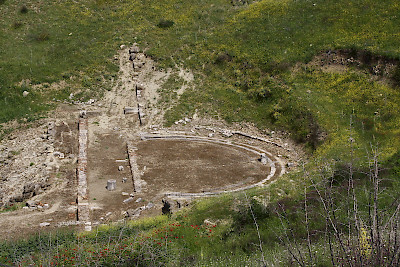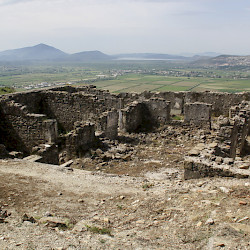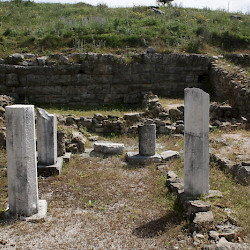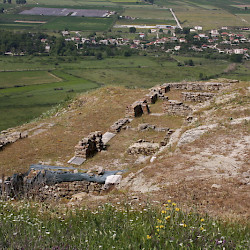Phoenice
Q781463Phoenice (Greek: Φοινίκη): main settlement of the Epirote Chaonians, later a Greek and Roman city, modern Finiq.
Origins

Phoenice was the main settlement of the Chaonians, one of the three main tribal confederations (koina) in the Epirus. Situated on a steep hill, Phoenice controlled the Bistrica valley between Buthrotum, seventeen kilometers to the south, and the Ionian Sea in the north. Phoenice's own port was Onchesmos (modern Saranda).
The oldest archaeological remains date back to the fifth century BCE and the oldest reference to the Chaonian capital is on the list of the Theorodokoi from Argos and Epidauros, which means that the Chaonians were considered to be sufficiently Greek to take part in the games. In those days, Phoenice belonged to the Molossian kingdom, which had been an ally of Macedonia since about 360 BCE. (To cement the alliance, a princess of the royal house, Olympias, had married king Philip II of Macedonia; their son was Alexander the Great.) After the death of king Alexander of Molossis, his kingdom fell apart and the Chaonians regained some independence, making Phoenice their capital. In 297 BCE, king Pyrrhus reunited the Epirotes again and Phoenice became one of his main residences.
Hellenistic Age
The city walls, with huge polygonal stones common to the Epirote cities, were built towards the end of the fourth century BCE or at the beginning of the third century. Polybius calls them the strongest of Epirus and mentions Phoenice as a prosperous city.note In this period, the city also started to mint its own coins. Archaeologists have investigated some of the fortifications, the city agora, and private residences from this age.
After the demise of the Epirote kingdom in 231 BCE, Phoenice was briefly integrated in the Illyrian kingdom of king Agron and queen Teuta,note but the Romans put an end to it in the First Illyrian War (229-228). Several years later, in 205, the Peace of Phoenice put an end to the First Macedonian War.note Slowly, Phoenice became part of the Roman sphere of influence, causing disturbances during the Third Macedonian War.note
The treasury house or Thesauros, a simple Doric temple with two columns in the front, dates back to the third century. It is similar to the Hellenistic phase of the Asclepius temple in Buthrotum and the so-called Temple of Aphrodite in Dodona.
 Phoenice, Wall |
 Phoenice, Shops |
 Phoenice, House with the Two Peristyles |
 Phoenice, Cistern |
Roman Age
In the Roman period, the city may have been in decline. The Greco-Roman geographer Strabo mentions the town only in passing.note Still, many buildings were restored and cisterns were built. The theater, built in the third century BCE, was reconstructed as well. Archaeologists also identified a luxurious residential complex, called “House with two Peristyles”. It continues earlier structures, dating back to, again, the Hellenistic age. In the neighborhood, the remains of shops have been identified. At the foot of the hills is a Roman necropolis.
Late Antiquity
In Late Antiquity and the Early Middle Ages, Phoenice remained inhabited. One of the most important buildings from this period is the Christian basilica with three naves and an atrium, dating from the fifth- or sixth centuries. In this period, the ancient treasury house was reused as a baptistery. According to Procopius, the Byzantine emperor Justinian (r.527-565 CE) restored the town.note It may have been abandoned after the Avars had invaded the Balkan Peninsula and had triggered the Slavic migrations.